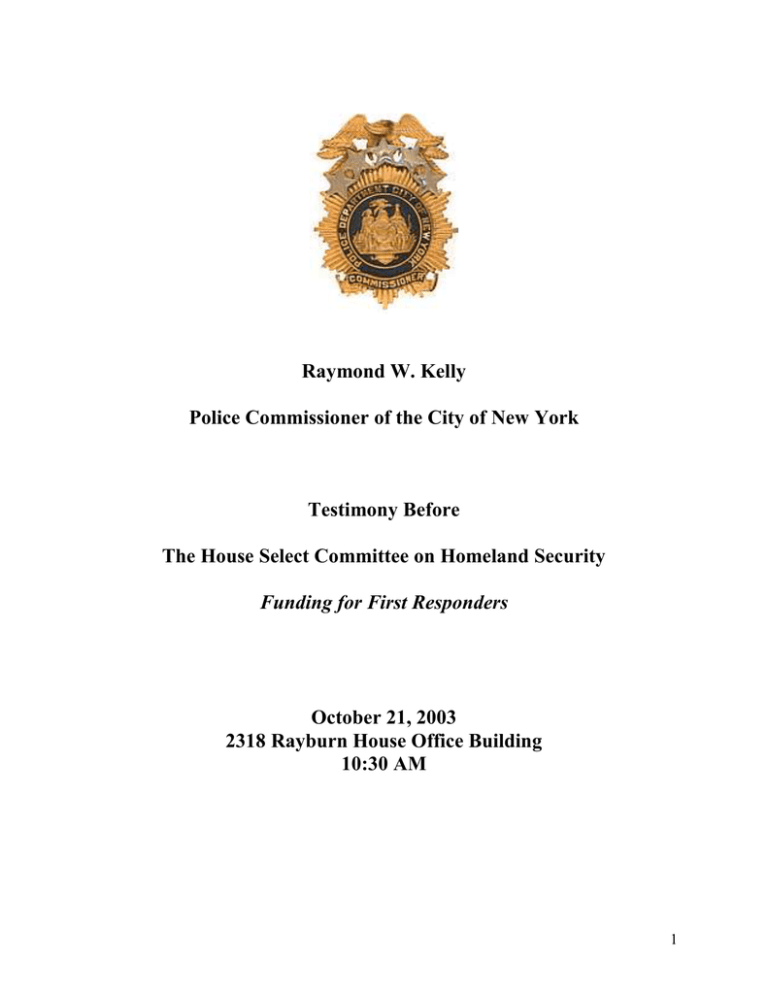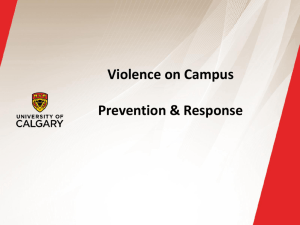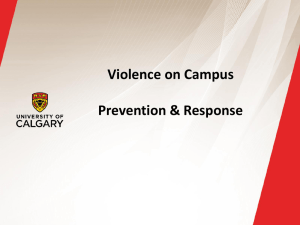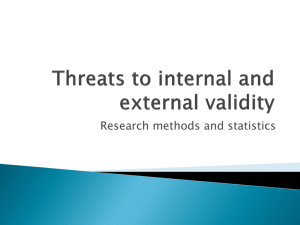Raymond W. Kelly Police Commissioner of the City of New York
advertisement

Raymond W. Kelly Police Commissioner of the City of New York Testimony Before The House Select Committee on Homeland Security Funding for First Responders October 21, 2003 2318 Rayburn House Office Building 10:30 AM 1 Testimony of Raymond W. Kelly Police Commissioner of the City of New York The House Select Committee on Homeland Security Funding for First Responders October 21, 2003 Chairman Cox, Congressman Turner and Members of the Committee, thank you for the opportunity to discuss with you what New York City has done and is doing in response to the terrorist attacks of September 11 and to the continuing terrorist threat, especially as it concerns New York City. There is no question that the terrorist threat to New York City is serious and ongoing. As recently as February of this of this year, a tough, seasoned Al Qaeda operative named Iyman Faris was in New York City on a mission to destroy the Brooklyn Bridge. This is the same man who fought alongside Osama Bin Laden, who engaged in a battle which included the wholesale slaughter of Russian prisoners, and who helped supply Al Qaeda fighters more recently with sleeping bags, airline tickets, cash and cell phones. Nearly two years after the destruction of the World Trade Center, Iyman Faris was in New York City. He stayed in a hotel near Newark airport. He rented a car there and drove into Manhattan. He ate at a Pakistani restaurant a few blocks from City Hall. And after conducting surveillance of the Brooklyn Bridge, Faris reported back to his handlers that, “the weather is too hot;” meaning security was too tight for the plot to succeed. I want to stress, again, that an experienced Al Qaeda operative, linked directly to Bin Laden, was in Manhattan plotting to destroy the Brooklyn Bridge just eight months ago. We know how Al Qaeda thinks: If at first you don’t succeed, try, try again. They viewed the first attack on the World Trade Center as a failure. So they came back. New York City has been the target of six separate plots -- that we know of -- by Islamic terrorists in the last decade alone. There was the first bombing of the World Trade Center in 1993, followed by the plot to simultaneously attack the Lincoln and Holland Tunnels, the George Washington Bridge, the United Nations, and 26 Federal Plaza -- the Federal office complex in lower Manhattan. Fortunately that plot was uncovered, as was another plot in 1997 to attack the New York City subway system. This was followed, of course, by the horrendous destruction of the World Trade Center in 2001. Two more plots against New York City, one involving the Garment District, and the one to destroy the Brooklyn Bridge were underway this year when they too were uncovered. The highly visible security that the New York City Police Department had in place on the Brooklyn Bridge, in addition to the unseen protection, appeared to pay off in the Faris case. The added coverage we have been providing at sensitive locations like the Brooklyn Bridge is just the tip of the iceberg in a comprehensive counter-terrorism strategy. At the beginning of 2002, we created a new Counter Terrorism Bureau. We assigned over 250 officers to it. About half of them were posted to the Joint Terrorist Task Force with the FBI. On September 11th of 2001 we had 17 detectives assigned to the Task Force. Now 121 are assigned there. 2 When all is said and done, we have about a thousand police officers directly involved in protecting the city against another terrorist attack. We also dramatically expanded the role of our Intelligence Division. We are conducting around-the-clock threat assessments, and integrating this real-time information into daily decisions about where to place resources and personnel. We appointed outstanding individuals from outside the Department to lead our intelligence and counter-terrorism functions. They have decades of CIA, counter terrorism and national security experience. We built a new counter terrorism center from scratch and staffed it with police officers who speak Farsi, Urdu, Arabic, and Pashto. We have sent New York City detectives with the FBI to Guantanamo, Cuba and to Afghanistan to interrogate terrorist suspects there. We have also sent our detectives to other international capitals to work directly with their counterparts in tracking down any threats to New York. At home, we are engaged in extensive training, and we are conducting drills on a daily basis. Our Hercules teams, comprised of specially trained officers, with heavy weapons, appear unannounced at sensitive locations. They are there to respond to a terrorist incident and to disrupt the kind of surveillance we know Al Qaeda engages in. We also regularly conduct something we call Sampson drills, involving teams of up to 100 officers at a time, including snipers, who can be dispatched quickly to any given location in the city. Our detectives meet with suppliers of explosives, laboratory equipment, scuba gear, specialized rental equipment… just about anything that a terrorist may want to acquire in advance of an attack. The Police Department has also held briefing sessions for various segments of the public who may come in contact with terrorist plotters. For example, we briefed real estate agents on exactly what Al Qaeda tells its operatives to look for in renting an apartment. Last March, with the commencement of the war in Iraq, we launched a heightened security program called “Operation Atlas” to protect New York City from possible reprisal. Given the ongoing terrorist threat, Operation Atlas remains in place today. It brings together all of the core elements of the Police Department; Patrol, specialized units, Counter Terrorism, and our Intelligence Division, in a coordinated defense of New York City. Checkpoints are established periodically at key locations into and out of Manhattan. COBRA teams, which specialize in biological and radiological response, have been deployed throughout the city. We have increased protection of commuter ferries. Archangel teams, composed of emergency services personnel, bomb experts and investigators, have been staged across the city. Hammer teams, the police and fire department experts in hazardous materials, have been deployed jointly. We are also having teams of officers board subway trains, and search them carby-car for anything suspicious. We want to discourage or even intercept a terrorist attack in the subway system. We have put a medical team together to help us train and protect police officers who might face biological or other unconventional weapons. The short version is this: We are doing a lot, and it is costing us a lot; something on the order of $200 million a year in operational expenses for counter terrorism in the Police Department alone. The police department has also identified $261 million in training needs, equipment and supplies directly related to counter terrorism. We asked the Federal government for $261 million. We’ve 3 received a little less than $60 million. And that $261 million does not include requests from other NYC departments. Only recently has financial help from the Federal government begun to arrive. We are grateful for the help, but it does not come anywhere near the needs that we have. Part of our challenge is, of course, the fiscal restraints under which we all must operate. You may not be able to do anything about those. But you can correct the system that sends more than 80% of the Federal assistance to first responders across the country in a manner that is blind to the threats this country faces, blind to the vulnerable infrastructure that exists in different places, and blind to the consequences of an attack. The City of New York’s initial estimate of its counter terrorism needs for all agencies was $900 million. I have attached a summary of that estimate to my testimony and would like to submit a more detailed description for the record. To date, the City has been awarded about $84 million in assistance from the Federal government for homeland security. It began arriving in August of this year. We expect that an additional $75 million will be approved from fiscal 2003 funds. I want to thank all those who helped create and who funded the High Threat Urban Area program but, as you can see, far and away, the people and City of New York are bearing the cost of defending the homeland in New York. This is despite New York being the number one target and that the consequences of an attack there could have national and worldwide repercussions. Of the total of approximately $160 million in Federal assistance for New York City, eighty percent of those funds have come from the High Threat Urban Area program, even though that program accounts for only about twenty percent nationally of the federal assistance for first responders. The High Threat Urban Area program attempts to compensate for the failure of the other programs to address the country’s counter-terrorism needs. Unfortunately, it does not succeed in correcting the lack of any consideration for threat in the other programs. In fiscal 2003, the Federal government provided a total of $3.45 billion for first responders through the Department of Homeland Security in three major programs: $1.9 billion in homeland security formula grants to states, $750 million in Firefighter Assistance Grants, and $800 million for high threat urban areas. Only the last program for High Threat Urban Areas – which was only 23% of the total - takes into account terrorist threat, vulnerabilities and consequences. In fiscal 2004, the total amount and proportion of funds being distributed on the basis of threat and need will decline. For this year, high threat urban areas will receive $725 million, nearly a ten percent cut, while the other programs will receive $2.95 billion, more than a ten percent increase. The result is that more than 80% of the Department of Homeland Security’s first responder funds will be distributed blind to the nation’s counter-terrorism needs. Let me first tell you why I am including the firefighter assistance grants in these totals. I recognize that there are needs in many communities throughout the country and that the Firefighter Assistance grant program existed prior to the events of September 11, but it has been increased greatly in response to September 11. I am not suggesting that those funds should be distributed on the basis of threat, but neither can their existence be ignored. Because these grants are limited to a maximum of $750,000 per jurisdiction, they are of little help in those areas that 4 have significant counter-terrorism needs, though they can be a significant help to rural areas and smaller communities. Regarding the Homeland Security formula grants to the states, they were created after the events of September 11 and are a direct response to those terrorist attacks. They should be distributed on the basis of known threats, the presence of critical infrastructure and the magnitude of the consequences of an attack. Currently, those grants are distributed completely otherwise. Each state receives three-quarters of one percent of the total amount and the remainder is distributed on the basis of the state’s population. The result is virtually a complete mismatch between the funding provided under this program and the need, as evidenced by the Department of Homeland Security’s funding of the high threat urban areas. I have attached a table that compares the funding received by the ten states that received the most high threat urban area funds and their ranking, on a per capita basis, of the formula grants. New York, which received the most high threat funds, ranked 49th in the formula grants. California, which received the second most high threat funds, ranked 50th. Texas, which received the third most high threat funds, ranked 48th. Incidentally, Mr. Chairman, I was Commissioner of U.S. Customs when Ahmad Ressam, the millennium bomber, was captured by Customs inspectors as he attempted to smuggle explosives into the U.S. as part of a plot to bomb Los Angeles International Airport. More evidence, I believe, that Al Qaeda focuses on high profile, major city targets. It is clear that large amounts of the first responder funding are not going where they are needed. The result is wasted resources and, much worse, a population placed at risk of attack and of the economic consequences of an attack. Some have suggested that the high threat funds “make up” for the misdirected block grant and firefighter grants but the goal is not to even out every state and locale. We are in a war against terror and we must deploy our resources where they will do this country the most good. In light of this, I have a few recommendations. First, the funds in all of the programs to assist first responders established after September 11 should be distributed on the basis of three factors – known threats, the presence of vulnerable critical infrastructure, and the consequences of an attack. I want to thank Chairman Cox, Congressman Turner and Congressman Sweeney for introducing legislation that would move these programs in that direction. Second, as you can see from my description of the steps that New York has taken, personnel costs are a significant part of the expense. Consequently, overtime costs and the personnel costs associated with training and with filling positions while personnel are being trained should be eligible uses of the funds. Third, the funds should be directed to local governments. Currently, this is done by requiring a minimum pass-through to local governments. In New York, the City and the State are working very well together. However, it may be that the Department of Homeland Security should have 5 the authority to provide grants directly to regional consortiums, as is provided for in Chairman Cox’s bill. I would also recommend that the Department have the authority to provide grants directly to individual local governments, as was done in the first round of High Threat Urban Area grants. The funds should not require maintenance of effort on the part of the local governments as a condition of the grant. Such a requirement can result in the denial of Federal assistance just when it is needed most. Unlike the federal government, local governments cannot run deficits. As a result they may have to cut expenditures and if there is a maintenance of effort requirement they could become ineligible for federal grants. Similarly, any matching requirements should be interpreted to include, for example, in kind contributions. Finally, State and local governments should be able to make procurement purchases through the federal contracts already negotiated by the General Services Administration. In New York, for example, the City can purchase equipment through statewide contracts. If State and local governments were able to do this through federal contracts, it would be more expeditious, help ensure the interoperability of the equipment and would probably produce a cost savings. The City has its own budget difficulties. This year the City of New York closed an $8 billion deficit. The deficit for next year is estimated to be an additional $2 billion. Although the Mayor has attempted to protect the Police Department from cuts, even we have had to reduce our expenses. I would just like to note here, that the City estimated that it lost $3 billion in revenues directly as a result of the September 11 attacks, and not as a result of the general economic slowdown, in 2002 and 2003. That estimate was reviewed and validated by the General Accounting Office. Although the City has been promised $20 billion from the federal government post-September 11, that figure will cover only about one-quarter or less of the actual losses, both to the City and the City economy, from the attack. The City did not receive any Federal assistance for lost tax revenues. We are grateful for the Federal assistance received to date but the City needs further assistance to meet the threats posed by this war on terror. Thank you for this opportunity. I would be happy to work with you on any proposals and I will be glad to answer any questions. Attachment Emergency Preparedness and Response Needs of First Responders City of New York New York City has 5 first responder agencies – New York Police Department (NYPD), Fire Department of New York (FDNY), Office of Emergency Management (OEM), Department of Health and Mental Hygiene (DHMH), and Health and Hospitals Corporation (HHC). These agencies are responsible for the prevention of and response to any terrorist attacks in New York City, with its resident population of approximately 8 million and approximately 11 million population total during the workday. New York City is the center of national and international finance, media and diplomacy. It has been a target of six Al Qaeda-linked attacks, twice successfully. 6 The City has taken steps to protect against terrorist attacks, including establishing a Counterterrorism Bureau and expanding its Intelligence Bureau in the NYPD. One thousand police officers are now devoted to these activities. The City has undertaken emergency planning and preparation in all of the first response agencies. Virtually all of these efforts have been funded from the City’s own funds despite the City’s struggles to meet the more usual responsibilities of a municipality in a time of large City deficits. However, these funds will apparently be distributed through existing programs that were not designed to prepare the country for a terrorist attack. The risk of terrorist attack is not distributed by population. New York City is approximately 2.85 percent of the nation’s population and Washington DC is approximately 0.2 percent. Those two cities represent far more than 3 percent of the risk of attack. New York’s 5 first responder agencies have identified $900 million in needs. The Federal Government should provide that one-third to half of the first responder funds go directly to 3 or 4 or 5 local jurisdictions most at risk of attack and with the largest needs – including New York City and Washington, DC. In addition, the First Responder and Bioterrorism programs must not be funded by eliminating existing federal programs that currently provide funding for the City, such as the Local Law Enforcement Block Grant or the State Criminal Alien Assistance Program (SCAAP) 7 EMERGENCY PREPAREDNESS AND RESPONSE NEEDS CITY OF NEW YORK FIRST RESPONDERS Counterterrorism, Intelligence and Public Safety $200,000,000 Training for First Responders Police Fire Dept. of Health and Mental Health Public Hospitals Subtotal $ $ $ $ $ 40,053,028 41,761,026 16,050,000 1,861,600 99,725,654 Security Enhancements for Facilities Police Fire Office of Emerg. Managment Dept. of Health and Mental Health Public Hospitals Subtotal $ 90,256,275 (included under equipment) $ 6,500,388 $ 78,195,000 $ 12,788,825 $187,740,488 Emergency Preparation and Response Equipment Police Fire Office of Emerg. Managment Dept. of Health and Mental Health Public Hospitals Subtotal $ 81,848,251 $ 76,150,000 $ 7,448,690 $ 10,368,185 $ 13,712,179 $189,527,305 Communications and Information Technology Police Fire Office of Emerg. Management Dept. of Health and Mental Health Public Hospitals Subtotal TOTAL $ 49,484,646 $160,000,000 $ 9,183,429 (included under facilities) $ 5,301,000 $223,969,075 $900,962,522 8 ATTACHMENT COMPARISON OF RANKING OF HIGH THREAT FUNDING AND BLOCK GRANT FUNDING PER CAPITA FISCAL 2003 The Department of Homeland Security distributes First Responder funds through two basic programs – High Threat Urban Area programs, where the funds are distributed based on an assessment of the threat of a terrorist attack, and State Block Grants where the funds are distributed under a formula where each state gets the same flat amount and the remainder of the funds are distributed based on population. Under the Block Grants, which account for more than 70 percent of the First Responder funding, there is no consideration at all of the threat of terrorist attack. The chart below shows how the 10 states that received the most High Threat Urban Area funding rank on a per capita basis under the block grant programs. STATE RANK FOR HIGH THREAT FUNDING RANK FOR BLOCK GRANT PER CAPITA New York 1 49 California 2 50 Texas 3 48 Illinois 4 45 Maryland1 5 32 Washington 6 36 Virginia1 7 39 Pennsylvania 8 46 Florida 9 47 New Jersey 10 42 1 Funding for the National Capital Area ($60.6 million) was divided evenly between Maryland and Virginia. 9








